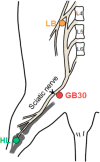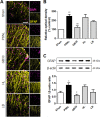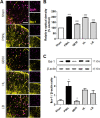Muscovite nanoparticles mitigate neuropathic pain by modulating the inflammatory response and neuroglial activation in the spinal cord
- PMID: 32394976
- PMCID: PMC7716045
- DOI: 10.4103/1673-5374.282260
Muscovite nanoparticles mitigate neuropathic pain by modulating the inflammatory response and neuroglial activation in the spinal cord
Abstract
Despite numerous efforts to overcome neuropathic pain, various pharmacological drugs often fail to meet the needs and have many side effects. Muscovite is an aluminosilicate mineral that has been reported to have an anti-inflammatory effect, but the efficacy of muscovite for neuropathic pain has not been investigated. Here, we assessed whether muscovite nanoparticles can reduce the symptoms of pain by controlling the inflammatory process observed in neuropathic pain. The analgesic effects of muscovite nanoparticles were explored using partial sciatic nerve ligation model of neuropathic pain, in which one-third to one-half of the nerve trifurcation of the sciatic nerve was tightly tied to the dorsal side. Muscovite nanoparticles (4 mg/100 μL) was given intramuscularly to evaluate its effects on neuropathic pain (3 days per week for 4 weeks). The results showed that the muscovite nanoparticle injections significantly alleviated partial sciatic nerve ligation-induced mechanical and cold allodynia. In the spinal cord, the muscovite nanoparticle injections exhibited inhibitory effects on astrocyte and microglia activation and reduced the expression of pro-inflammatory cytokines, such as interleukin-1β, tumor necrosis factor-α, interleiukin-6 and monocyte chemoattractant protein-1, which were upregulated in the partial sciatic nerve ligation model. Moreover, the muscovite nanoparticle injections resulted in a decrease in activating transcription factor 3, a neuronal injury marker, in the sciatic nerve. These results suggest that the analgesic effects of muscovite nanoparticle on partial sciatic nerve ligation-induced neuropathic pain may result from inhibiting activation of astrocytes and microglia as well as pro-inflammatory cytokines. We propose that muscovite nanoparticle is a potential anti-nociceptive candidate for neuropathic pain. All experimental protocols in this study were approved by the Institutional Animal Ethics Committee (IACUC) at Dongguk University, South Korea (approval No. 2017-022-1) on September 28, 2017.
Keywords: astrocyte; microglia; muscovite; nanoparticle; neuropathic pain; partial sciatic nerve ligation; pharmacopuncture; pro-inflammatory cytokine; spinal cord.
Conflict of interest statement
None
Figures






Similar articles
-
Epigenetic transcriptional activation of monocyte chemotactic protein 3 contributes to long-lasting neuropathic pain.Brain. 2013 Mar;136(Pt 3):828-43. doi: 10.1093/brain/aws330. Epub 2013 Jan 30. Brain. 2013. PMID: 23364351
-
Targeting macrophage and microglia activation with colony stimulating factor 1 receptor inhibitor is an effective strategy to treat injury-triggered neuropathic pain.Mol Pain. 2018 Jan-Dec;14:1744806918764979. doi: 10.1177/1744806918764979. Mol Pain. 2018. PMID: 29546785 Free PMC article.
-
A critical time window for the analgesic effect of central histamine in the partial sciatic ligation model of neuropathic pain.J Neuroinflammation. 2016 Jun 24;13(1):163. doi: 10.1186/s12974-016-0637-0. J Neuroinflammation. 2016. PMID: 27342775 Free PMC article.
-
Hyperbaric oxygenation therapy alleviates chronic constrictive injury-induced neuropathic pain and reduces tumor necrosis factor-alpha production.Anesth Analg. 2011 Sep;113(3):626-33. doi: 10.1213/ANE.0b013e31821f9544. Epub 2011 May 19. Anesth Analg. 2011. PMID: 21596875
-
Neuroinflammation, Bone Marrow Stem Cells, and Chronic Pain.Front Immunol. 2017 Aug 21;8:1014. doi: 10.3389/fimmu.2017.01014. eCollection 2017. Front Immunol. 2017. PMID: 28871264 Free PMC article. Review.
Cited by
-
Z-Guggulsterone Relieves Neuropathic Pain by Inhibiting the Expression of Astrocytes and Proinflammatory Cytokines in the Spinal Dorsal Horn.J Pain Res. 2022 May 5;15:1315-1324. doi: 10.2147/JPR.S360126. eCollection 2022. J Pain Res. 2022. PMID: 35546904 Free PMC article.
-
Biodegradable nanoparticles targeting circulating immune cells reduce central and peripheral sensitization to alleviate neuropathic pain following spinal cord injury.Pain. 2024 Jan 1;165(1):92-101. doi: 10.1097/j.pain.0000000000002989. Epub 2023 Jul 14. Pain. 2024. PMID: 37463227 Free PMC article.
-
Down-regulating Circular RNA Prkcsh suppresses the inflammatory response after spinal cord injury.Neural Regen Res. 2022 Jan;17(1):144-151. doi: 10.4103/1673-5374.314114. Neural Regen Res. 2022. PMID: 34100450 Free PMC article.
-
Unveiling the effects of Rosa canina oligosaccharide liposome on neuropathic pain and motor dysfunction following spinal cord injury in rats: relevance to its antioxidative effects.Front Pharmacol. 2025 Feb 14;16:1533025. doi: 10.3389/fphar.2025.1533025. eCollection 2025. Front Pharmacol. 2025. PMID: 40028155 Free PMC article.
-
Ethanolic Extracts of Cissus quadrangularis Linn. (Vitaceae) Attenuate Vincristine-Induced Peripheral Neuropathy in Rats: An Evidence of the Antioxidant, Calcium Inhibitory, and Neuromodulatory Properties.Adv Pharmacol Pharm Sci. 2024 Dec 12;2024:8822369. doi: 10.1155/adpp/8822369. eCollection 2024. Adv Pharmacol Pharm Sci. 2024. PMID: 39703364 Free PMC article.
References
-
- Andreev N, Urban L, Dray A. Opioids suppress spontaneous activity of polymodal nociceptors in rat paw skin induced by ultraviolet irradiation. Neuroscience. 1994;58:793–798. - PubMed
-
- Averill S, Michael GJ, Shortland PJ, Leavesley RC, King VR, Bradbury EJ, McMahon SB, Priestley JV. NGF and GDNF ameliorate the increase in ATF3 expression which occurs in dorsal root ganglion cells in response to peripheral nerve injury. Eur J Neurosci. 2004;19:1437–1445. - PubMed
-
- Benyamin R, Trescot AM, Datta S, Buenaventura R, Adlaka R, Sehgal N, Glaser SE, Vallejo R. Opioid complications and side effects. Pain Physician. 2008;11(2 Suppl):S105–120. - PubMed
-
- Calvo M, Dawes JM, Bennett DL. The role of the immune system in the generation of neuropathic pain. Lancet Neurol. 2012;11:629–642. - PubMed
LinkOut - more resources
Full Text Sources
Research Materials

